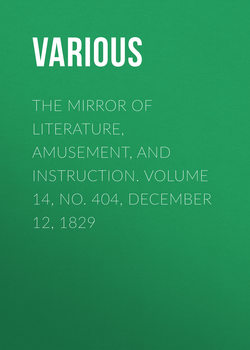Читать книгу The Mirror of Literature, Amusement, and Instruction. Volume 14, No. 404, December 12, 1829 - Various - Страница 2
FINE ARTS
ОглавлениеGOTHIC ARCHITECTURE
(For the Mirror.)
The following explanation of a few of the terms employed to designate parts of Gothic architecture, may, perhaps, prove acceptable to some of your readers. Having felt the need of such assistance in the course of my own reading, &c. &c.—I extracted them from an expensive work on the subject, and have only to lament that my vocabulary should be so defective.
Buttresses.—Projections between the windows and at the corners.
Corbel.—An ornamental projection from the wall to support an arch, niche, beam, or other apparent weight. It is often a head or part of a figure.
Bands.—Either small strings around shafts, or horizontal lines of square, round, and other formed panels, used to ornament spires, towers, and similar works.
Cornice.—The tablet at the top of a wall, running under the battlement. It becomes a
Basement when at the bottom of it, and beneath this the wall is generally thicker.
Battlement.—It may be indented or plain; sunk, panelled, or pierced.
Crockets.—Small bunches of foliage, ornamenting canopies and pinnacles.
Canopies.—Adorned drip-stones.—Vide Dripstone.
Crypts.—Vaulted chapels under some large churches, and a few small ones.
Crisps.—Small arches; sometimes double-feathered, and according to the number of them in immediate connexion; they are termed tre-foils, quatre-foils, cinque-foils, &c.
Dripstone.—The tablet running round doors and windows.
Featherings or Foliations.—Parts of tracery ornamented with small arches and points, are termed Feathered, or Foliated.
Finials.—Large crockets surmounting canopies and pinnacles. This term is frequently applied to the whole pinnacle.
Machicolations.—Projecting battlements, with intervals for discharging missiles on the heads of assailants.
Mullions.—By these, windows are divided into lights.
Parapet.—When walls are crowned with a parapet, it is straight at the top.
Pinnacle.—A small spire, generally four-sided, and placed on the top of buttresses, &c., both exterior and interior.
Piers.—Spaces in the interior of a building between the arches.
Rood Loft.—In ancient churches, not collegiate, a screen between the nave and chancel was so called, which had on the top of it a large projection, whereon were placed certain images, especially those which composed the rood.
Set-offs.—The mouldings and slopes dividing buttresses into stages.
Spandrells.—Spaces, either plain or ornamented, between an arch and the square formed round it.
Stoups.—The basins in niches, which held holy water. Near the altar in old churches, or where the altar has been, is sometimes found another niche, distinguished from the stoup, by having in it at the bottom, a small aperture for carrying off the water; it is often double with a place for bread.
Tabernacle-work.—Ornamented open work over stalls; and generally any minute ornamental open-work.
Tablets.—Small projecting mouldings or strings, mostly horizontal.
Tracery.—Ornaments of the division at the heads of windows. Flowing, when the lines branch out into flowers, leaves, arches, &c. Perpendicular, when the mullions are continued through the straight lines.
Transoms.—The horizontal divisions of windows and panelling.
Turrets.—Towers of great height in proportion to their diameter are so called. Large towers have often turrets at their corners; often one larger than the other, containing a staircase; and sometimes they have only that one.
BRITISH STYLES OF ARCHITECTURE, AND THEIR DURATION
The Norman—Commenced before the conquest, and continued until the reign of Henry II. A.D., 1189. It is characterized by semicircular, and sometimes pointed, arches, rudely ornamented.
Early English.—This style lasted until the reign of Edward I., A.D. 1307. Its characteristics are, pointed arches, long narrow windows, and the jagged or toothed ornament.
Decorated English—Lasted to the end of Edward III., A.D. 1377. It is characterized by large windows with pointed arches divided into many lights by mullions. The tracery of this style is in flowing lines, forming figures. It has many ornaments, light and delicately wrought.
Perpendicular English.—This last style employed latterly only in additions, was in use, though much debased, even as late as 1630-40. The latest whole building in it, is not later than Henry VIII. Its characteristics are the mullions of the windows, and ornamental panelings, run in perpendicular lines; and many buildings in this style are so crowded with ornament, that the beauty of the style is destroyed. The carvings of it are delicately executed.
M.L.B.
